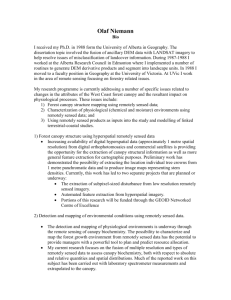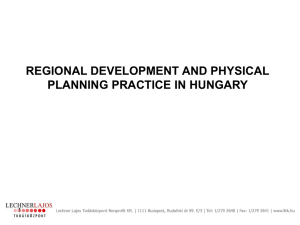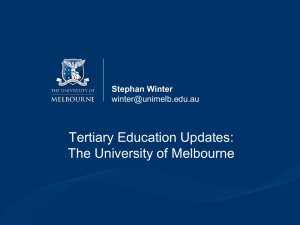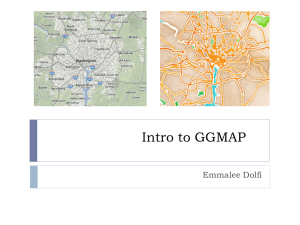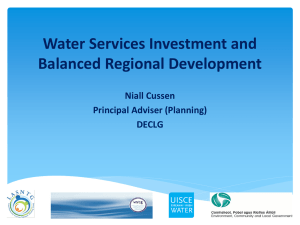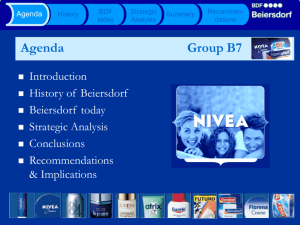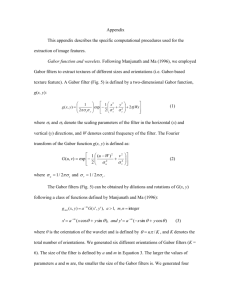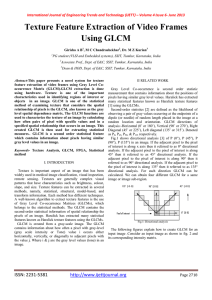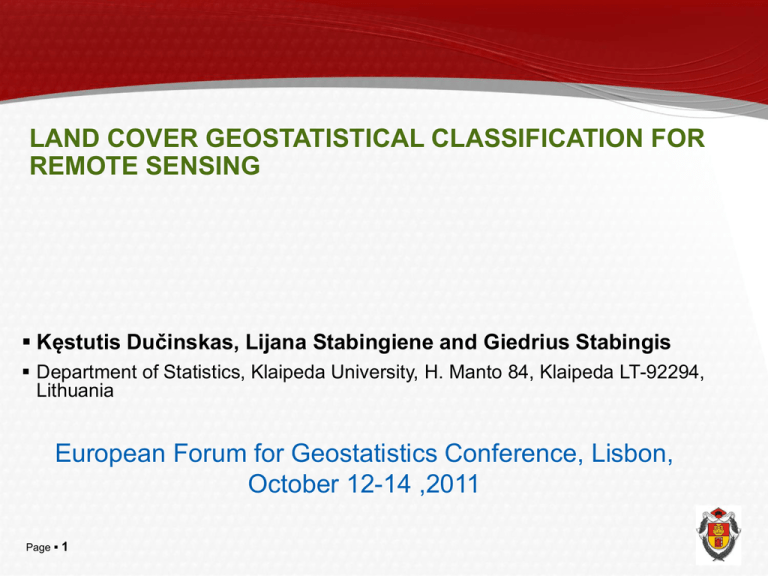
LAND COVER GEOSTATISTICAL CLASSIFICATION FOR
REMOTE SENSING
Kęstutis Dučinskas, Lijana Stabingiene and Giedrius Stabingis
Department of Statistics, Klaipeda University, H. Manto 84, Klaipeda LT-92294,
Lithuania
European Forum for Geostatistics Conference, Lisbon,
October 12-14 ,2011
Page 1
Intoduction
Page 2
Relevance and the main objective
Problem - non geostatistical
classification methods are
not efficient when territory is
covered by the smoke of fire.
Objective – to increase
accuracy of land cover
classification from remotely
sensed imagery
Territory is covered with the spatially correlated smoke.
Image from NASA MODIS satellite.
Page 3
Proposed geostatistical
classification technique is
realised in the examples with
images corrupted by spatially
correlated Gaussian noise.
Introduction 1
Switzer [1] was the first to treat classification of spatial data.
For features based on Gaussian Markov model, the influence
of texture rotation to image classification is considered by
Deng and Clausi [2].
Spatial contextual classification problems arising in geospatial
domain is considered by Shekhar [3].
Atkinson, Naser [4], [5] incorporated geostatistical information
of features into plug-in versions of classifiers based on the
marginal distribution of the observation to be classified.
Page 4
Introduction 2
Image classification problem is to divide an observed image
into several homogeneous regions by labeling pixels, based
on feature information and on information about spatial
adjacency relationships with training sample.
The stationary Gaussian Random Field (GRF) model for
features and MRF model for class labels are considered.
In the case of partial parametric uncertainty, the plug-in BDF
is proposed.
This is the generalization of the discriminant function derived
in the case of training sample with fixed training sample and
fixed prior probabilities for labels [6].
Page 5
Introduction 3
Geostatistical techniques that utilise spatial information in classification
can be split into two distinct groups.(Atkinson,2000)
In the first, spatial information is used to provide data on texture. It is
implicit in such approaches that texture varies spatially across the image,
and particularly between the classes of interest, so that data on texture
can be used to inform classification (pixel-by pixel classification) .
In the second group, spatial information is used to smooth the classified
image. The rationale for smoothing is that inaccuracies that arise from
simple spectral classification applied on a pixel-by-pixel basis can be
reduced using the spatial dependence between neighbouring pixels.
Proximate pixels are likely to be similar and this dependence can be
formalised and utilised to increase classification accuracy. The goal is to
choose a smoothing function based upon this spatial dependence.
Page 6
Methods 1
The marginal model of the observation Z(s) in class is
Z s l s
the error term is generated by zero-mean stationary GRF
s : s D
with covariance function:
cov s , u 2 r s u , s, u D,
r (s u)
2
- spatial correlation function,
- scale parameter.
L {1,2} - label set,
Sn si D ; i 1,..., n - set of training pixels.
Page 7
,
Methods 2
T Z , Y
- training sample.
Y (Y ( s1 ),..., Y ( sn )) - labels vector.
Z ( Z ( s1 ),..., Z ( sn )) - features vector
Assume that the Z model for given Y=y is
Z X y E.
Assumption. The conditional distribution of Y(s0) given T=t
depends only on Y=y, i.e.
l ( y ) P(Y ( s0 ) l | T t ), l 1, 2.
Page 8
Methods 3
Dependent BDF classification
BDF for the classification of Z0 given T=t (with Z=z, Y=y)
under the Assumption is:
Wt Z 0 Z 0
0
1t
0
2t
.
2 10t 20t 02t ( y )
where
( y) ln 1 ( y) 2 ( y)
Page 9
.
Methods 3
If Z0 is assumed to be independent to T,
then BDF (BDFI) is implemented by Atkinson(2004,2010).
It has a following form
W Z0 Z0 1 (s0 ) 2 (s0 ) 2 1 (s0 ) 2 (s0 ) 2 ( y)
Page 10
Methods 4
Bayes error rate for BDF
P0 (Wt ( Z 0 )) l 1 l ( y ) 0 n 2 1 ( y) 0 n
2
l
.
.
Bayes error rate for BDFI
.
P0 (W ( Z 0 )) l 1 l ( y ) 0 2 1 ( y ) 0
2
l
.
Page 11
Methods 4
PBDF to the classification problem based on BDF
Wt Z0 ; ˆ Z0 ˆ10t ˆ 20t 2 ˆ10t ˆ 20t ˆ02t ( y)
PBDFI to the classification problem based on BDFI
(If Z0 is assumed to be independent to T)
ˆ Z0 ˆ1 ˆ 2 2 ˆ1 ˆ 2 ˆ 2 ( y)
W Z0 ;
Page 12
Methods 5
The actual error rate for PBDF
ˆ l ( y) Qˆl (t )
P Wt Z0 ,
l 1
2
where
l
ˆ
Ql (t ) 1 lt0 ˆ10t ˆ 20t 2 ˆ10t ˆ 20t / ˆ 02t
( y ) /
Page 13
ˆ
0
1t
ˆ
ˆ , l 1,2
0 2
2t
2
0t
2 2
0t
Methods 5
The actual error rate for PBDFI
2
ˆ
P W Z0 , l 1 l ( y) Qˆ *l (t )
l
*
ˆ
Ql (t ) 1 l ˆ1 ˆ 2 2 ˆ1 ˆ 2 / ˆ 2
( y) /
Page 14
ˆ1 ˆ 2
2
2
ˆ
2 2
, l 1, 2
Land cover classification example
•The example of land cover classification from remotely
sensed image into two classes (Woodland:black;
Grassland:white).
•Additive stationary GRF with isotropic exponential
covariance is applied to the image.
•Such situation can occur during fire or fog.
•Our proposed classification methods, using different
PBDF and PBDFI are applied.
Page 15
Land cover classification example
N0=NN(16) neighborhood model is used.
Supervised classification methods are compared with
unsupervised classification method using co-occurrence
matrices (GLCM) by using the empirical error rates.
Page 16
Forest territory classification example
Real satellite
image crop
Page 17
Image with spatially
correlated GRF
Training sample
Classification results of real image
Classification
with PBDF
Classification
with PBDFI
Classification with
GLCM average
The empirically calculated errors.
DF
Pˆ 1| 2
Pˆ 2 |1
Page 18
PBDF
PBDFI
GLCM
0.0363
0.0369
0.0502
0.0151
0.0153
0.0352
Classification results of corrupted images
α
10
30
50
Page 19
Image for
classification
Results with
PBDF
Results with
PBDFI
Results with
GLCM average
Classification results of corrupted images
α
10
30
50
Page 20
Empirical errors
PBDF
PBDFI
GLCM average
Pˆ 1| 2
0.2174
0.2222
0.3236
Pˆ 2 |1
0.0733
0.0770
0.1424
Pˆ 1| 2
0.1496
0.1540
0.9201
Pˆ 2 |1
0.0283
0.0302
0.5865
Pˆ 1| 2
0.1502
0.1542
0.4771
Pˆ 2 |1
0.0656
0.0678
0.2651
Conclusions
The results of performed calculations give us the strong
argument to encourage the users do not ignore the spatial
dependence in image classification and reconstruction.
The advantage of BDF against BDFI and the advantage of
PBDF against PBDFI are shown numerically and visually in
image restoration and in remotely sensed image classification
examples.
Page 21
References
[1] Switzer P. Extensions of linear discriminant analysis for statistical
classification of remotely sensed satellite imagery. Math. Geol 1980; 12:367–
376.
[2] Deng H, Clausi DA. Gaussian MRF rotation invariant features for image
classification. IEEE Trans Pattern Anal Machine Intell 2004; 26(7):951-955.
[3] Shekhar S, Schrater PR, Vatsavai RR, Wu W, Chawla S. Spatial
contextual classification and prediction models for mining geospatial data.
IEEE Trans on Multimedia 2002; 4(2):174-188.
[4] Atkinson, P. M. (2004). Spatially weighted supervised classification for
remote sensing. International journal of applied earth observation and
geoinformation, 5 , 277–291.
[5] Atkinson, P. M., & Naser, D. K. (2010). A geostatistically weighted k-nn
classifier for remotely sensed imagery. Geographical analysis, 42 , 204–225.
[6] Dučinskas K. Approximation of the expected error rate in classificattion of
the gaussian random field observations. Statistics and Probability Letters
2009, 79:138–144.
Page 22
Thank you for your attention.
Page 23




